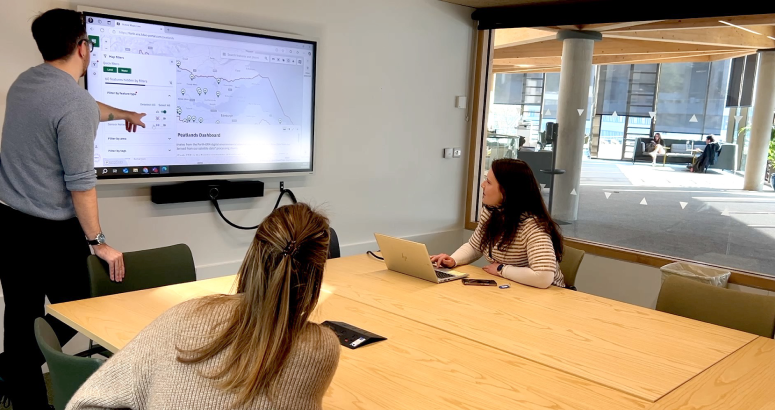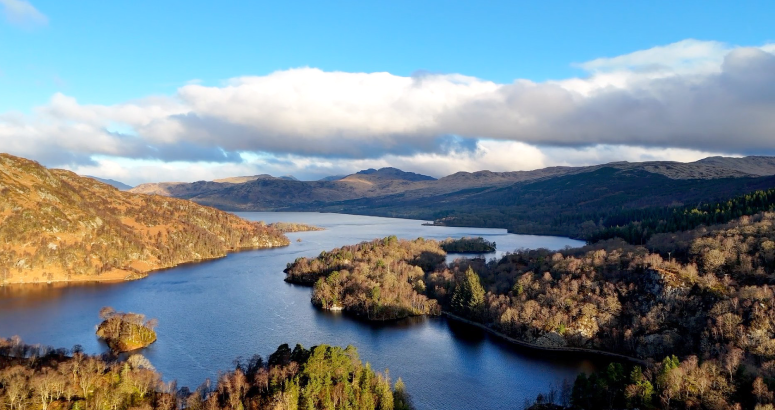Research to Shine Light on Importance of Healthy Peatlands in Climate Fight
14 May 2025High-tech
A range of high-tech scientific monitoring equipment has been installed in two locations on land above Loch Katrine as part of the project.
A range of high-tech scientific monitoring equipment has been installed in two locations on land above Loch Katrine, where Scottish Water is carrying out one of its biggest peatland restoration projects to date, to collect and compare data on the levels of carbon stored within healthy peatland compared to that which is dried out and degrading.
A water quality monitoring buoy has also been deployed on the loch itself to capture data on the levels of dissolved carbon in the water, as well as other organic material that has been washed into the loch from the surrounding land during heavy rainfall.
A team of data scientists will then analyse the long-term changes in the quality of the water in Loch Katrine and the impact of implementing the peatland restoration work.
One of the researchers on the peatland project, which is set to run for two years, Professor Jens-Arne Subke said: “Our objective is to understand and evaluate how successful the work to restore the peatland has been. With continuous monitoring, we are hoping to build up a good understanding of how fluxes of greenhouse gas and eroded peat in stream water changes over time following restoration.”
Peatland restoration involves reprofiling sharp peat faces which are often badly eroded and exposed to return the peatland to a more natural state where new vegetation can thrive, and which helps to hold water in the land.
This prevents peat and other organic matter being washed off the land and into source waters, as well as helping to capture carbon from the atmosphere.

Data collection
The research aims to gather data to show the impact of the peatland restoration work on water quality and carbon capture.
Since work got underway in January, over 50 hectares of peatland has now been restored at Loch Katrine, with the aim of reaching 400 hectares over the next decade. Work has now been paused until later in the year due to the bird nesting season.““Loch Katrine is one of our biggest peatland restoration projects at 400 hectares so we have got to collate the evidence to demonstrate how effective this work is. ”
Elise Cartmell
General Manager Zero Emissions at Scottish Water
General Manager Zero Emissions at Scottish Water, Elise Cartmell, said: “Loch Katrine is one of our biggest peatland restoration projects at 400 hectares so we have got to collate the evidence to demonstrate how effective this work is.
“Peatland restoration is absolutely vital to us as it reduces the amount of organic matter that’s going into our source waters. With climate change we are getting these very intense rainfall events and that’s driving that organic carbon off the hillside into our source waters.
"I’m really hoping that from this season we’ll be able to start seeing changes, whether that’s with the water level, whether that’s with water quality – I can’t wait to have a look and see what that data is showing us right from the start.”
Professor Peter Hunter from the University of Stirling added: “We’re hoping that over time we will be able to see that the restoration work has helped reduce the loss of carbon from the peatlands and therefore the concentration that we see in Loch Katrine itself.”
The projects are part of the Hydro Nation Chair Research & Innovation Programme which brings Scotland’s water sector together to focus on how to achieve net zero. It is hosted by the University of Stirling and funded by Scottish Water.
The restoration work at Loch Katrine has received funding through Peatland ACTION, a national programme to restore Scotland’s peatlands, and is part of a wider land management plan for the catchment, in partnership with long-term tenant Forestry and Land Scotland.
It also forms part of the Loch Lomond and Trossachs National Park Partnership Plan.

Loch Katrine
Peatland restoration and woodland creation are both being undertaken at the loch, in a bid to protect the water quality and improve biodiversity.








